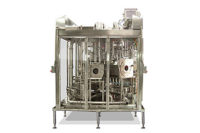When consumers grow interested in what is in their food, they read product labels. And when shoppers read product labels that include potassium sorbate, nisin, maltodextrins, carrageenan, sodium benzoate and so on, they put your product back on the shelf.
After several weeks of stagnant sales, the store manager calls the distributor and says he will not carry the products anymore. The distributor calls the manufacturer and says “no one wants your product” and stops all weekly orders.
As the manufacturer, you stop or substantially curtail production and your plant is left with hundreds of thousands of pre-labeled containers and a workforce that starts taking more coffee breaks since it is not busy filling product orders.
The caffeine-laden plant workers then build play structures from the thousands of cups laying around the plant and start climbing on them to use up their nervous energy. Someone falls, gets hurt and sues your company.
Don’t get sued! Get thinking. Use label-friendly approaches to improve product shelf life.
While this full scenario is unlikely, the reality is that consumers want clean product labels and expect good product shelf life.
Fermentation is effective
Fermentation of foods was originally a means of preserving the nutrients for later consumption. Lactic fermentations produce a wide array of metabolic products that are effective antimicrobial compounds and can help to stabilize the milk gel structures that are desired in cultured dairy products.
While such metabolic products can be there in significant quantities, they do not trigger a label declaration since they are the result of fermentation and not an added ingredient. Additionally, there are “consumer friendly” food ingredients that when directly added to cultured dairy products impart desirable improvements in shelf life, texture and flavor.
Enhancing the shelf life
Several lactic acid bacteria produce a range of compounds that have antimicrobial activity against bacteria, yeasts and molds, which enhance the shelf life. One class of these metabolites from lactic acid bacterial growth are organic acids (lactic, formic, acetic and propionic) that lower the pH and serve in their undissociated form as effective antibacterial agents. Bacteriocins (lacticin, nisin, thermophilin, pediocin) are proteins and polypeptides that are produced by lactic acid bacteria and can have bactericidal activity. These bacteriocins have been shown to have activity against pathogenic and spoilage microorganisms.
Many lactic acid bacteria produce hydrogen peroxide, which acts as a strong oxidizing agent to destroy bacterial activity. Additionally, when this hydrogen peroxide is coupled with the naturally present lactoperoxidase-thiocyanate system in milk, hypothiocyanates and other products form and inhibit growth of undesirable spoilage microorganisms.
Low molecular weight carbonyls produced during lactic fermentations, like diacetyl, which is known for its desirable flavor characteristics, is also antimicrobial at low pH. While the diacetyl levels are generally lower than what is necessary to be antimicrobial, its presence along with other antimicrobial compounds produced during lactic fermentation may have a role in control of spoilage bacteria.
The production of many of these antibacterial compounds is species- and strain-specific. For example, while production of bacteriocins by lactic acid bacteria is common, many strains of lactic acid bacteria used in multistrain cultures have not included those strains that produce bacteriocins. Hence, the heightened awareness for “label friendly” ingredient statements will elevate the value of production of antibacterial compounds as a higher priority in culture selection and development.
Packing and process innovation
The basic principles of effective cleaning and sanitation can work wonders to insure good product shelf life.
Taking advantage of the latest “clean fill and sealing” technologies can also be helpful. Another option is the use of carbon dioxide to extend product shelf life, as long as you don’t mind your ingredient statement saying “carbon dioxide (to preserve product quality). It has been used very effectively in cottage cheese, extending shelf life to as long as 35 to 75 days.
Taking full advantage of heat treatments to insure appropriate heat denaturation for gel strength and water-holding capacity makes perfect sense in this context. Additionally, post-fermentation handling of the product (minimal shear, proper cooling) can also insure that the texture of the fermented products does not get destroyed by the time it reaches the consumer.
Clean labels and great product quality over an extended shelf life are the prerequisites for strong product sales. Hopefully, this will avoid any unintended consequences of long and complicated ingredient statements.




